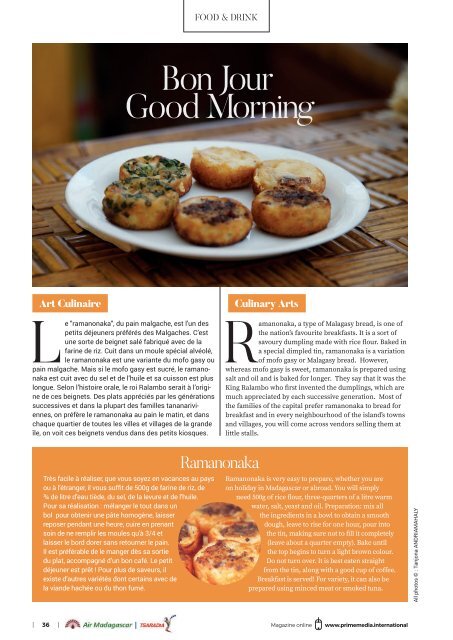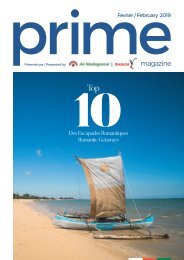PRIME MAG - AIR MAD - MARCH 2019 - SINGLE PAGES - LO-RES
You also want an ePaper? Increase the reach of your titles
YUMPU automatically turns print PDFs into web optimized ePapers that Google loves.
FOOD & DRINK<br />
Bon Jour<br />
Good Morning<br />
Art Culinaire<br />
L<br />
e "ramanonaka", du pain malgache, est l'un des<br />
petits déjeuners préférés des Malgaches. C’est<br />
une sorte de beignet salé fabriqué avec de la<br />
farine de riz. Cuit dans un moule spécial alvéolé,<br />
le ramanonaka est une variante du mofo gasy ou<br />
pain malgache. Mais si le mofo gasy est sucré, le ramanonaka<br />
est cuit avec du sel et de l’huile et sa cuisson est plus<br />
longue. Selon l’histoire orale, le roi Ralambo serait à l’origine<br />
de ces beignets. Des plats appréciés par les générations<br />
successives et dans la plupart des familles tananariviennes,<br />
on préfère le ramanonaka au pain le matin, et dans<br />
chaque quartier de toutes les villes et villages de la grande<br />
île, on voit ces beignets vendus dans des petits kiosques.<br />
Culinary Arts<br />
Ramanonaka, a type of Malagasy bread, is one of<br />
the nation’s favourite breakfasts. It is a sort of<br />
savoury dumpling made with rice flour. Baked in<br />
a special dimpled tin, ramanonaka is a variation<br />
of mofo gasy or Malagasy bread. However,<br />
whereas mofo gasy is sweet, ramanonaka is prepared using<br />
salt and oil and is baked for longer. They say that it was the<br />
King Ralambo who first invented the dumplings, which are<br />
much appreciated by each successive generation. Most of<br />
the families of the capital prefer ramanonaka to bread for<br />
breakfast and in every neighbourhood of the island’s towns<br />
and villages, you will come across vendors selling them at<br />
little stalls.<br />
Très facile à réaliser, que vous soyez en vacances au pays<br />
ou à l’étranger, il vous suffit de 500g de farine de riz, de<br />
¾ de litre d’eau tiède, du sel, de la levure et de l’huile.<br />
Pour sa réalisation : mélanger le tout dans un<br />
bol pour obtenir une pâte homogène, laisser<br />
reposer pendant une heure, cuire en prenant<br />
soin de ne remplir les moules qu'à 3/4 et<br />
laisser le bord dorer sans retourner le pain.<br />
Il est préférable de le manger dès sa sortie<br />
du plat, accompagné d’un bon café. Le petit<br />
déjeuner est prêt ! Pour plus de saveurs, il<br />
existe d’autres variétés dont certains avec de<br />
la viande hachée ou du thon fumé.<br />
Ramanonaka<br />
Ramanonaka is very easy to prepare, whether you are<br />
on holiday in Madagascar or abroad. You will simply<br />
need 500g of rice flour, three-quarters of a litre warm<br />
water, salt, yeast and oil. Preparation: mix all<br />
the ingredients in a bowl to obtain a smooth<br />
dough, leave to rise for one hour, pour into<br />
the tin, making sure not to fill it completely<br />
(leave about a quarter empty). Bake until<br />
the top begins to turn a light brown colour.<br />
Do not turn over. It is best eaten straight<br />
from the tin, along with a good cup of coffee.<br />
Breakfast is served! For variety, it can also be<br />
prepared using minced meat or smoked tuna.<br />
All photos © : Tanjona ANDRIAMAHALY<br />
| 36 | Magazine online www.primemedia.international















